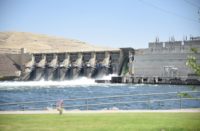| + Click to Enlarge Map |
 |
| (Map by the U.S. Army Corps of Engineers) |
A judge ordered the federal agencies involved in the operation of the massive hydropower system on the Columbia and Snake rivers to rewrite the "biological opinion" controlling operation of the 14 dams, or risk the consequence of a court takeover of river operations. He also held out the option of breaching the four Snake River dams if the agencies fail to cooperate to save 13 endangered salmon species.
"The governments inaction appears to some parties to be a strategy intended to avoid making hard choices and offending those who favor the status quo," wrote Judge James Redden of the U.S. District Court in Portland in a ruling released late Oct. 7.
The judge also cited interference from the White House and Congress in letting the agencies fulfill their obligations under the Endangered Species Act (ESA) and of not providing adequate funding to undertake the needed analysis.
"If the Executive and Legislative Branches do not allow [the Action Agencies] to follow the law of the land, the Action Agencies will fail again to take the steps that are plainly necessary to do what the ESA requires and what the listed species require in order to survive and recover," wrote Redden.
He ordered the agencies to work openly with the plaintiff coalition of environmental, tribal and fishing groups to produce a new plan within a year.
Required by the ESA, a biological opinion, or BiOp, describes wildlife status in an area affected by federal actions. Written by the National Oceanic and Atmospheric Administration, the Bureau of Reclamation and the Army Corps of Engineers, the federal hydropower BiOp concluded that operational changes or significant dam modifications were not required to prevent salmon extinction in the Columbia River watershed.
EarthJustice (Seattle), the plaintiff coalition, argued that the BiOp illegally shifted the baseline from restoration of historic runs to protection of existing numbers of fish, and allowed hatchery-bred fish to replace declining wild fish.
The judge also found the BiOp to be insufficiently "verifiable and quantifiable," said Ed Mosey, spokesperson for the Bonneville Power Administration (BPA), citing the absence of concrete plans or measures of success. BPA markets the power generated at the dams.
"The government has never been willing to define salmon recovery," said Amy Kouber, spokesperson for the Seattle office of American Rivers, a plaintiff. "They just want to tweak operations a bit here and there, and thats not enough."
|
Federal agencies had promised to spend $6 billion over the next 10 years on ecosystem wide efforts to restore salmon habitat and to make some fish-friendly physical modifications to the dams to avoid fish kills in turbines. However, this is being done outside of the BiOp process, said Mosey, and the proposals do not include operational changes to aid fish.
A sticking point is the release of water over or through the dams in ways that help fish but dont allow it to be simultaneously used for power generation.
Earlier this year, the same judge forced federal operators to "spill" water over the dams for the summer migration of juvenile salmon to the ocean, costing the region about $80 million in lost power revenue, according to BPA. This "hot button issue" along with selective dam removal are both on the table now, said Mosey, cautioning that the federal agencies have 60 days to appeal, an option not yet ruled out.


Post a comment to this article
Report Abusive Comment